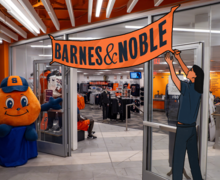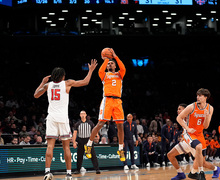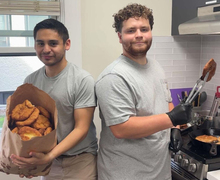Black & Banned Books Read-In engages readers with challenged literature
Charlie Hynes | Contributing Photographer
Attendees gathered to participate in SU’s Black & Banned Books Read-In, which featured a collection of banned and challenged books written by or about Black Americans. J'Ana Myers, a sophomore majoring in policy studies, chose to read from “All Boys Aren’t Blue,” a non-fiction memoir by writer and activist George M. Johnson.
Get the latest Syracuse news delivered right to your inbox.
Subscribe to our newsletter here.
As students and professors entered Syracuse University’s Martin Luther King Jr. Memorial Library Tuesday afternoon, library staff directed them toward a table of books and asked them to choose one that interested them.
Attendees gathered to participate in SU’s Black & Banned Books Read-In, which featured a collection of banned and challenged books written by or about Black Americans from the 19th century to the present day. The event commemorated the annual national Banned Books Week initiative.
The African American Studies department, the Barner-McDuffie House and the School of Information Studies’ Library and Information Science program hosted the read-in to encourage and celebrate the “freedom to read.” In the past two years, more than 10,000 books have been banned in United States public schools — more than tripling from 3,362 books the previous year, The Guardian reported.
“It’s not just a legal issue, it’s a cultural and social sensibility about who has a right to determine what other people have access to, how they should think and what they should know — not just children, but adults as well,” Joan Bryant, an associate professor in AAS and the read-in’s founder, said.
Bryant began the meeting with a welcome to attendees and explained that each reader was allotted three minutes to introduce themselves, explain their book choice and read a chosen passage. Some readers’ selections included “The New Jim Crow” by Michelle Alexander, “And Still I Rise” by Maya Angelou and “The Color Purple” by Alice Walker, among others.
Kristian Brown, a sophomore studying psychology, has been working at the library with Bryant since last year and helped set up the event.
“The overall goals of the Banned Books event was to not only spread awareness about the knowledge of banned books, but to be a sort of rebellion, to read the books that are banned that aren’t supposed to be read, ” Brown said.
Bryant began hosting Black & Banned events 10 years ago at the Beauchamp Branch Library in Syracuse’s Eastside neighborhood with several of her students, she said. The program moved on campus a few years later and has grown in size since then.
While the collection of books encompassed a variety of genres — from memoirs to children’s picture books — all had been banned or challenged by public officials, private groups, bookstores, prisons and other distributors at some point during the last century, according to the event’s handout.
It’s not just a legal issue, it’s a cultural and social sensibility about who has a right to determine what other people have access to.Joan Bryant, AAS associate professor
Several students said they chose books they had previously read as children, highlighting the significance literature had on their perception of Black identities.
J’Ana Myers, a sophomore majoring in policy studies, said she fears the lack of Black representation in libraries could harm children’s education and self-image. Myers said she’s familiar with banned book policies because she grew up in Georgia, which passed a law streamlining parental library book challenges in 2022.
“It’s very important that young Black children see themselves within art pieces,” Myers said. “We see Black people depicted in such a negative light … and banning books doesn’t allow children to hear about themselves in a positive light.
A common book choice among attendees was “All Boys Aren’t Blue,” a non-fiction memoir by writer and activist George M. Johnson about growing up Black and queer in New Jersey. The book was banned in school districts across Florida, Missouri, South Carolina, Texas, Utah and other states, making it one of the most banned books in the U.S. with a total of 29 school district bans.
“It’s quite scary to see it, and it kind of makes you feel small, to feel like you’re here and you support and you fight. Yet the government and the powers that be don’t support you, and they don’t want you to win,” Brown said. “They feel like you don’t want you to win.”
Brown said the conversation around banned books is important not just for attendees, but for the entire SU community because it allows for a wider understanding of Black diversity and combats ignorance.
The program will continue into Wednesday afternoon for a panel discussion on challenging book censorship hosted at Bird Library at 2 p.m., followed by a community read-out. Both events are also part of Banned Books Week.
“I really would urge people to come to these kinds of events. It’s very important, especially being a predominantly white university, to hear from Black people, authentic Black people, to be in these spaces to learn,” Myers said.
Published on September 24, 2024 at 10:58 pm
Contact Kate: kjacks19@syr.edu






